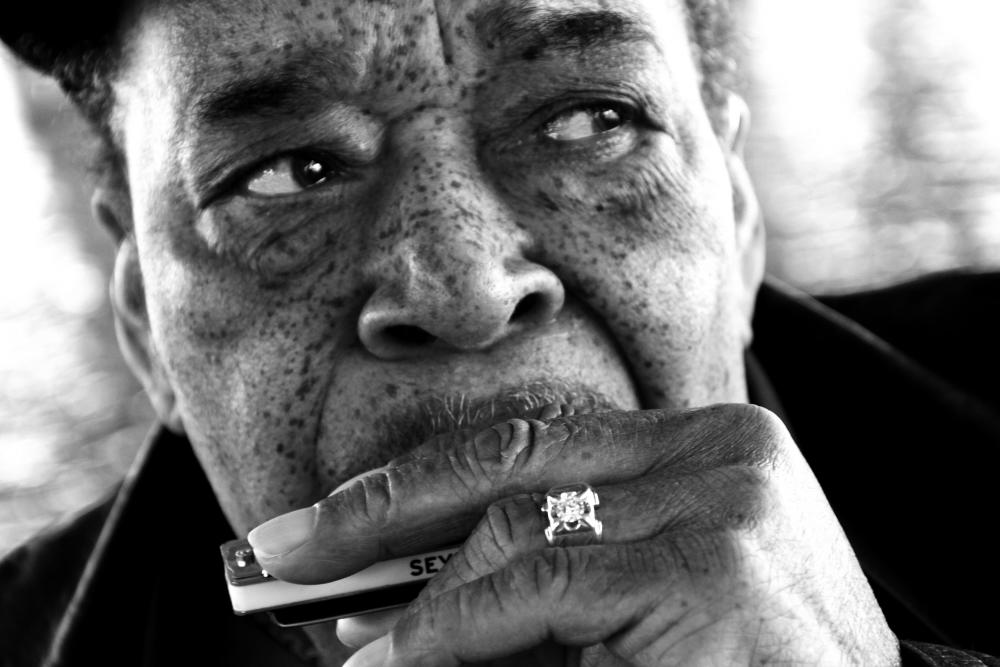Happy Birthday to the Blues Harp Master
Few harmonica players announce themselves by tone alone better than James Cotton. The great bluesman, born 80 years ago today in Tunica, Mississippi, has a huge, vibrato-laden sound, and no one else sounds like him. A certain level of doubt still revolves around the identity of the harp players on a handful of Muddy Waters records. Is it Little Walter, Big Walter, or Junior Wells? But since Cotton reached his mature style in the late fifties, there’s been no mistaking him.
Cotton’s early life is the stuff of picaresque legend. Before the age of ten, he heard Sonny Boy Williamson on his noontime radio broadcasts on KFFA in Helena, Arkansas, and was so awed that he left home and searched him out. Upon meeting, Cotton fabricated a story about being an orphan and persuaded the tempestuous old man to take him in. For the next several years, he lived with Williamson, and on occasion with Sonny Boy’s brother-in-law, Howlin’ Wolf. (This Sonny Boy, born Aleck “Rice” Miller in Glendora, Mississippi, adopted the show biz moniker of the popular Chicago-based harmonica great John Lee Williamson.)
By the early fifties, while still in his mid-teens, Cotton won an apprenticeship as second harmonica in Wolf’s band and made a downright inauspicious debut on Wolf’s “Dorothy Mae.” Three years later, on his 19th birthday, he recorded the classic Sun Records single,”Cotton Crop Blues” and “Hold Me in Your Arms.” He sang but blew no harp; the solo role was reserved for the crackling guitar of Pat Hare.
It took several more years for Cotton to distinguish himself as a player. In 1956, he and Hare joined Muddy Waters, and he spent the next decade with the band long renowned for providing harp players with their ultimate sideman showcase. Consider the succession: Little Walter Jacobs, Junior Wells, Henry “Pot” Strong, Big Walter Horton, Cotton, George “Harmonica” Smith, Paul Oscher, George “Mojo” Buford, and Jerry Portnoy. Along the way, Muddy also encouraged such masters as Paul Butterfield, Charlie Musselwhite, Danny Russo, Rick Estrin, and Kim Wilson.

Cotton was the longest-tenured of this line, but throughout the fifties, Little Walter was still called on to play on Muddy’s Chess Records dates. It wasn’t until 1959, on the memorial tribute, Muddy Waters Sings Big Bill, that Cotton was finally heard to full advantage playing “Just a Dream” and other Bill Broonzy classics.
The following year’s big-selling release, Muddy Waters at Newport, gave him even greater prominence. This is where “Got My Mojo Workin’” became established as Muddy’s concert closer, and it’s the earliest extant footage we have of the great bluesman at work. When Muddy first became popular with young whites in the late sixties, he often lamented that he couldn’t quite put it over like he had earlier in his career. A taste of what he meant is evident in the jitterbugging and other ribald antics he deploys at 6:10. That’s the aforementioned Pat Hare on guitar, Otis Spann at the piano, and the poet Langston Hughes, who hosted the Newport blues showcase, who comes on as emcee.
Cotton made his first album as a leader in 1964 when he was co-billed with Otis Spann on the Prestige/Bluesville release, The Blues Never Die, and the following year he cut loose on Chicago/The Blues/Today. Among the handful tunes he recorded for the Sam Charters-produced series was “Rocket 88,” the Jackie Brenston-Ike Turner classic that’s often proposed as the first rock’n’roll record. Cotton was only 16 when it was recorded in 1951, but he’s made the claim for himself as the song’s composer.
Buddy Guy says that Chicago Blues was “sit down blues” when he arrived from Louisiana in 1958. Here’s a later example of what he means on this mid-’60s special produced by the Canadian Broadcasting Corporation.
Cotton’s 1967 Verve Forecast debut, produced by Mike Bloomfield, featured the instrumental “Blues in My Sleep.” The tour de force remained a concert favorite for many years.
